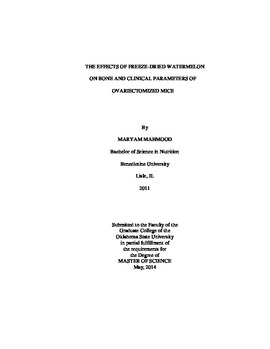| dc.contributor.advisor | Lucas, Edralin A. | |
| dc.contributor.author | Mahmood, Maryam | |
| dc.date.accessioned | 2015-06-17T20:06:50Z | |
| dc.date.available | 2015-06-17T20:06:50Z | |
| dc.date.issued | 2014-05-01 | |
| dc.identifier.uri | https://hdl.handle.net/11244/14982 | |
| dc.description.abstract | The role of fruits and vegetables in the prevention and treatment of chronic diseases such as osteoporosis are continuously being explored. The purpose of this study was to investigate the dose-dependent effects of freeze-dried watermelon in the prevention of bone loss in ovariectomized (OVX) mice, a model of post-menopausal osteoporosis. We hypothesized that compounds in watermelon such as lycopene and citrulline would help prevent bone loss in this animal model. Three month old C57BL/6 female mice (n=68) were sham-operated or OVX and randomly assigned to treatment groups for 12 weeks: sham-control (SHAM), OVX-control, OVX + 1%, 10% or 25% (w/w) freeze-dried watermelon (WM), or OVX-control with alendronate (OVX-ALN) injection (100 μg/kg body weight). All diets were isocaloric, isonitrogenous and had the same calcium and phosphorus concentrations. The 25% WM group had significantly higher final body weight and % body fat compared to the OVX-control group. The DXA scans using PIXImus showed watermelon was not able to prevent the decrease in whole body, tibial, and lumbar bone mineral content and density due to estrogen deficiency. Micro-computed tomography (μCT) analyses showed no similarities between WM-fed groups and SHAM for tibial trabecular and cortical bone microarchitecture. However, the lumbar trabecular micro-architecture analyses revealed that the WM 10% group had similar connectivity density to the SHAM group and higher than the other two doses of WM and OVX-control groups. Bone volume, structure model index and trabecular separation of the WM 10% group are similar to the SHAM and OVX-control groups. Watermelon supplementation increased liver catalase mRNA and tended to increase plasma glutathione peroxidase activity. Our data indicates that watermelon, in a moderate amount, might be a suitable dietary option for maintaining skeletal health. | |
| dc.format | application/pdf | |
| dc.language | en_US | |
| dc.publisher | Oklahoma State University | |
| dc.rights | Copyright is held by the author who has granted the Oklahoma State University Library the non-exclusive right to share this material in its institutional repository. Contact Digital Library Services at lib-dls@okstate.edu or 405-744-9161 for the permission policy on the use, reproduction or distribution of this material. | |
| dc.title | Effects of Freeze-dried Watermelon on Bone and Clinical Parameters of Ovariectomized Mice | |
| dc.type | text | |
| dc.contributor.committeeMember | Smith, Brenda J. | |
| dc.contributor.committeeMember | Clarke, Stephen L. | |
| osu.filename | Mahmood_okstate_0664M_13186.pdf | |
| osu.accesstype | Open Access | |
| dc.description.department | Nutritional Science | |
| dc.type.genre | Thesis | |
| dc.subject.keywords | bone | |
| dc.subject.keywords | fruit | |
| dc.subject.keywords | osteoporosis | |
| dc.subject.keywords | ovariectomized mice | |
| dc.subject.keywords | skeletal health | |
| dc.subject.keywords | watermelon | |
